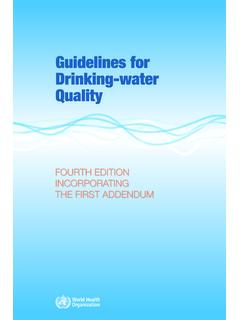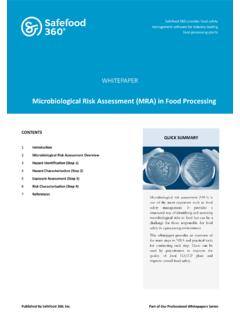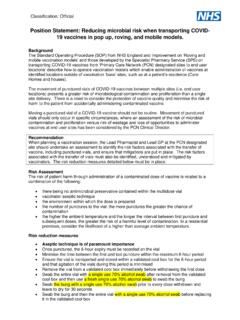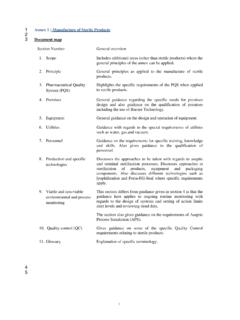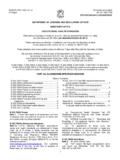Transcription of Case studies in food risk assessments Food Safety Specialist
1 Case studies in food risk assessments Lorraine McIntyre food Safety Specialist February 26, 2015. 1. What you're going to learn today . 1. Quick review of risk analysis theory 2. Practical application, where to start 3. Case studies a) FM: Shelf-life of refrigerated partially dried pasta b) FM: Raw cocoa/carob chocolate o Commercial or Natural/Organic c) Bakery couche d) Sous vide eggs e) FM: Flax/sunflower oil 2. Risk Analysis Risk assessment Risk Risk management communication 3. Risk management activities Seize or detain product Order product Suspend or destruction cancel licence Recall notice or Issue public advisory prohibition notice Increase/conduct On-site product testing inspections Review all documentation 4. Risk communication activities Inform stakeholders about outcome Attend a Suggest Policy Conference Consumers Industry Regulator -Calls & meetings Develop web- Write a peer -Emails site messaging reviewed paper -Tweets -Notices -Educate your operator Give a lecture Write an IN or PSA.
2 Inform Media 5. RISK assessment / COMMUNICATION / MANAGEMENT OVERVIEW FOR RECALLS/PSAs 6. RISK COMMUNICATION PHASE. 7. 8. Risk assessment Considerations Evaluate the evidence/. Collect background Examine food Examine food make information properties preparation recommendations Any history of FBI with Are food ingredients Identify and assess Are there enough this food in the past? safe for consumption food handling practices hurdles? and from an approved that contribute to risk Review literature & source? Lab evidence: do research available on Are hazards controlled counts meet product or food Review the 3 categories ( , CCP in the guidelines? What processing methods of hazards process)? additional tests are recommended? Are any ingredients in Identify standards for Is the food adequately the food potentially Do you have enough preparation of this processed to destroy hazardous?
3 Information about the food (if it exists) , &/or prevent growth of pathogens? food , food process to legislation, guidelines, Intrinsic factors (pH, make an informed laboratory testing, etc. Aw, antimicrobials, Are preservatives recommendation? nitrite). used? Is this a novel or common food ? Have Extrinsic factors we given advice on this (packaging, O2, storage What are the critical in the past? temp and time) limits? What do your shelf-life, use in other colleagues know? foods 9. 10. start by collecting some data EASY: google search and google scholar HARDER: OVID / PubMed [define search criteria & hits]. Search books; specific journals;. government/organizational authorities Talk to colleagues, e-mail authors in the field Collect food food Make info properties prepn Recommendns 11. The question: procrastination/.
4 12. Ingredients in pasta 1,2. Flour (semolina, farina, wheat flour). Water Eggs (sometimes). Hazards in these ingredients 3. Salmonella Staphylococcus aureus Spoilage moulds 1. University of Illinois Extension Service. Making fresh pasta. In: Department of Agriculture, editor. p. 1-3. 2. Pasta. 2013 [cited 2013 Sep 20]; Available from: Members. Microbial ecology of food commodities. 2nd edition. ed. Roberts TA, Pitt JI, Cordier JL, Gram L, Tompkin RB, Gorris LGM, et al., editors. New York: Kluwer Academic/Plenum Publishers; 2005. 13. What else do you need to know? Aw water activity 3,4. Fully Dried Pasta Partly Dried Pasta Fresh Pasta 6 3,4. Aw = to in between Aw = to Shelf-stable room ? Refrigerated 2 to 3. temperature check blog sites days Longer if 5. preservatives added 4. Costa C, Lucera A, Mastromatteo M, et al.
5 Shelf life extension of durum semolina-based fresh pasta. International Journal of food Science & Technology. 2010;45(8):1545-51. 5. Del Nobile MA, Di Benedetto N, Suriano N, et al. Use of natural compounds to improve the microbial stability of Amaranth-based homemade fresh pasta. food Microbiology. 2009;26(2):151-6. 6. Vahavipe. Barrier paper container - foods. 2004 [cited 2013 Sep 23]; Available from: 14. What else was found? Very little documentation on best practices for partially dried pasta;. Room temperature drying a risk for growth of Salmonella and heat stable S. aureus enterotoxin;3. Commercial pasta dried 55 C;2. Moisture resorption an issue; spoilage from mould/bacteria; pH drops from spoilage; coliforms increase after 3-4 days3,5. Water activity more important than temperature for controlling CFIA says the manufacturer must establish the shelf-life8.
6 7. Sautour M, Soares Mansur C, Divies C, et al. Comparison of the effects of temperature and water activity on growth rate of food spoilage moulds. J Ind Microbiol Biotech. 2002 2002/06/01;28(6):311-5. 8. Canadian food Inspection Agency. food Safety practices guidance for fresh non-filled alimentary paste manufacturers. 2013 [cited 2013 Sep 20]; Available from: paste/eng/1364412028942/1364414870197?ch ap=0#s11c5. 15. (evaluate evidence) Recommendations Measure the Aw < , store RT for several months > , store refrigerated for one week (7 days). Refrigeration prohibits growth of moulds, spoilage bacteria Test coliforms of pasta, at 0, 7 and 14 days to establish shelf-life if hold longer than one week Dry above 55 C to prohibit growth of bacteria Use pasteurized eggs to control for Salmonella Proper hygiene (& past.)
7 Eggs) to control for S. aureus 16. The question: dishes/raw-brownie/. 17. Chocolate desserts Raw chocolate Raw chocolate -commercial desserts desserts chocolate -homemade carob -commercial carob (TFM guideline) (TFM guideline) (TFM guideline). Sep 10, 2013 Sep 25, 2013 Mar 21, 2014. 18. Guidelines prior to 2014 Guidelines in 2014. Appendix 1 listing: Appendix 1 listing: chocolate (provided it is used chocolate (provided it is used as an ingredient in a food for re-melted or re-molded products only and (1) not that has undergone purchased from bulk bins;. cooking to at least 71 C. o (2) sourced from a (160oF) chocolate manufacturer that can provide a certificate of assurance that chocolate is free from Salmonella). 19. HACCP and process overview for milk chocolate manufacture National Confectioner's Association, 20.
8 Chocolate manufacturing facts: 49. Water activity low, between 43. to (low moisture food ) 3,5. 38. D-value during conching, 32. 1292 min (approx one day) at 60 C to 584 min at 50 C 3 27. 21. In the majority of outbreaks, contaminated cocoa seeds, and a failure to control Salmonella during roasting 3. Nascimento MdSd, Brum DM, Pena PO, et al. Inactivation of Salmonella during cocoa roasting and chocolate conching. International Journal of food Microbiology. 2012;159(3):225-9. 4. Cordier JL. HACCP in the chocolate industry. food Control. 1994;5(3):171-5. 5. Podolak R, Enache E, Stone W, et al. Sources and Risk Factors for Contamination, Survival, Persistence, and Heat Resistance of Salmonella in Low- Moisture Foods. Journal of food Protection. 2010;73(10):1919-36. 6. Beuchat LR, Komitopoulou E, Beckers H, et al. Low Water Activity Foods: Increased Concern as Vehicles of Foodborne Pathogens.
9 Journal of food Protection. 2013;76(1):150-72. 21. Recommendations for commercial chocolate: Chocolate sourced from reputable suppliers with certificates stated product tested and found free of Salmonella Chocolate not purchased from bulk- food bins Hygienic control in the process, education of operators Melted and re-molded chocolate CANNOT be re- molded again, but could be used in baked products Reword the TFM guidelines 22. Back to the original question: dishes/raw-brownie/. 23. Carob - Ceratonia siliqua 1. Chocolate substitute Low caffeine Low theobromine Made from beans2. locust beans, also used to make a food gum food process 2,4. Roast pods Wash carob Mill into Deseed pods ~150 C for 60. pods powder min 1. Wikipedia. Ceratonia siliqua. 2013 [cited 2013 Oct 16]; Available from: 2. Savarino G, Barbagallo RN.
10 Carob processing in Sicily: technological aspects and products. Industrie Alimentari. 2009;48(496):36-45. 4. Yousif AK, Alghzawi HM. Processing and characterization of carob powder. food Chemistry. 2000;69(3):283-7. 24. What else was found? no outbreaks/illnesses / no Cdn recalls Roasting reduces the pH of the pods from pH= to pH= HAZARDS (infer from cocoa processing). Physical 3 Chemical 3 Biological Stones Mycotoxins Salmonella 5-9. Metals / woods Aflatoxins VTEC 10-11. Allergen? Tree-nut B. cereus cereulide 12. 3. Laughter J, Brown DB, Anantheswaran RC. Manufacturing Chocolate for Entrepreneurial Endeavors. Specialty Foods: CRC Press; 2012. p. 157-98. Available from: Jasson V, Baert L, Uyttendaele M. Detection of low numbers of healthy and sub-lethally injured Salmonella enterica in chocolate. International Journal of food Microbiology.

